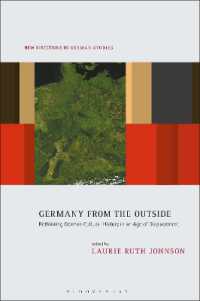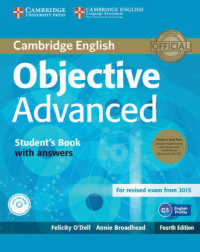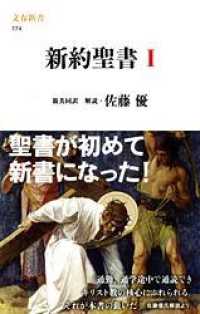- ホーム
- > 洋書
- > 英文書
- > History / World
Full Description
Scholars have long thought that, following the Muslim Golden Age of the medieval era, the Ottoman Empire grew culturally and technologically isolated, losing interest in innovation and placing the empire on a path toward stagnation and decline. Science among the Ottomans challenges this widely accepted Western image of the nineteenth- and early twentieth-century Ottomans as backward and impoverished.
In the first book on this topic in English in over sixty years, Miri Shefer-Mossensohn contends that Ottoman society and culture created a fertile environment that fostered diverse scientific activity. She demonstrates that the Ottomans excelled in adapting the inventions of others to their own needs and improving them. For example, in 1877, the Ottoman Empire boasted the seventh-longest electric telegraph system in the world; indeed, the Ottomans were among the era's most advanced nations with regard to modern communication infrastructure. To substantiate her claims about science in the empire, Shefer-Mossensohn studies patterns of learning; state involvement in technological activities; and Turkish- and Arabic-speaking Ottomans who produced, consumed, and altered scientific practices. The results reveal Ottoman participation in science to have been a dynamic force that helped sustain the six-hundred-year empire.
Contents
Preface
A Note on Transliteration
Introduction: What Is the History of Science?
The History of Science and Technology
The History of Islamic Science and Technology
The History of Ottoman Science and Technology History
Toward a History of Ottoman Scientific Experiences
On Inventiveness: An Ottoman Lesson
Chapter 1. Framing "Knowledge" in the Ottoman Empire
A Eurasian Matrix: The Multiple Cultural Sources of Knowledge in the Ottoman Empire
The Ottoman Concept and Epistemology of Knowledge: The Term cIlm
Classification of Knowledge in Muslim Societies
Amalgamation of Bodies of Knowledge in Muslim Societies
Tensions due to Fusion of Bodies of Knowledge: The Dispute regarding the Status of Pre-Islamic Sciences
Mediating Mechanisms of Reception
Chapter 2. Where and How Does Learning Take Place?
Pedagogy
New Educational Institutions and a New Type of Education in the Long Nineteenth Century
Chapter 3. Transfer of Knowledge to, from, and within the Ottoman Empire
Ottoman Literacy
Translations and Translators among the Ottoman Elite
Marginal Groups as Agents of Knowledge
The Passage of Travelers and Knowledge to and from the Empire
Chapter 4. State in Science: On Empire, Power, Infrastructures, and Finance
The Patron and the Scholar: Intisap and Waqf/Vakıf
Science and Technology and the Ottoman State Infrastructure
Science, State, and the State above It: The (Semi)Colonial Connection
Conclusion: Ottoman Science
A Teacher and a Student: MurtaḍÁ al-Zabīdī and cAbd al-Raḥmān al-Jabartī as Ottoman Scientists
Ottoman Patterns of Scientific Activity
Ottoman Innovation
Notes
Bibliography
Index








